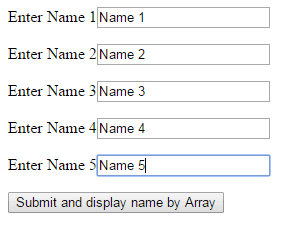
- Php associative array forms how to#
- Php associative array forms software#
- Php associative array forms code#
So I use Dictionary to form similar structure. net likely not support associative array.I struggling that should I use Dictionary to form similar structure because the Noted that the 3rd parameter for web service method. Result = mservice.call(sessionId, "sales_order.list", hashFilter) HashFilter.Add("created_at", filter_value) String sessionId = mservice.login("username", "apikey") mservice is instance of service reference that point to URL of corresponding SOAP API.call() is soap API method
Php associative array forms code#
I need to convert above code in c#.net for further development that need to run in Windows Server environment.įollowing is my code in c# and problem I facing. $result = $client->call($sessionId, 'sales_order.list', $params) get all of the sales_order on and status is pending $params = array(array( $sessionId = $client->login('apiUser', 'apiKey') $client = new SoapClient(' / If somestuff requires api authentification, The API code in php.įollowing code works fine in php.
Php associative array forms software#
The order doesn't matter.I need to write an in-house software in c#.net that need to call web service's method via SOAP API. With this, you can define already in the form, in which form the data should be available later. In addition, as you can see, we are completely free in the arrangement and can mix normal fields between array fields. Of course you can also transfer any number of arrays next to each other and combine them with non-array fields: Īnd then read out in PHP: $field = $_POST įoreach ($otherarray as $value) echo $value This makes it easier to keep the individual fields apart. In our PHP script we can address the individual fields directly using their assigned names: // receive all data in an array Alternatively, we can give the individual fields in the array names and thus get an associative array: In our first example, by writing we got a numerically indexed array. So we save ourselves the work of addressing and reading out each field individually.

In this example we assign $_POST to a variable, and then iterate through the array element by element. We can work with the array like a normal PHP array: // receive all data in an array In our example we use $_POST to access the value that the user entered in the first field. The first array field from our form has the index 0, the second 1 and so on.

In our PHP script we can receive the array with $_POST and access the transferred values: // output a single value The name "field" is arbitrary, but each input field must have the same name field so that all user entries are later in the same array. The key to being able to receive the data entered by the user directly as an array are the square brackets.

In our first example, we have three input fields and we want to receive their content in our PHP script "script.php" as just one array. A first exampleįirst, let's look at a simple example. Typical applications are, for example, forms with numerous fields of the same type or forms in which a previously unknown number of fields is created dynamically.
Php associative array forms how to#
In this tutorial, I will show you, how to do this. It is often quite handy to receive inputs from a form directly as an array in a PHP script to be able to directly start processing the data in the correct form.


 0 kommentar(er)
0 kommentar(er)
